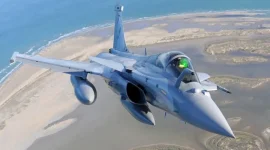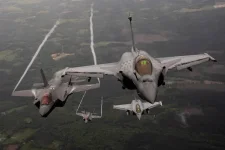- Views: 3K
- Replies: 14
The Indian Air Force (IAF) is considering the acquisition of an additional 20 Advanced Medium Combat Aircraft (AMCA) Mk1 jets to ensure the manufacturing ecosystem remains active during the shift to the more advanced Mk2 variant.
This strategic move aims to prevent a potential production stoppage of 18 to 24 months, which could otherwise disrupt supply chains and the skilled workforce at the production facility.
The AMCA is India’s ambitious fifth-generation aircraft program, designed to be the future backbone of the IAF's fighter fleet.
The initial plan involves the production of 40 AMCA Mk1 aircraft, which will be powered by the American General Electric F414 engine. Following this, production is slated to transition to the significantly upgraded AMCA Mk2.
To avoid a prolonged idle period at Hindustan Aeronautics Limited's (HAL) Nashik plant between these two phases, the procurement of 20 more Mk1 jets is being evaluated as a crucial stopgap measure.
Development and production of this next-generation fighter will be managed through a new Special Purpose Vehicle (SPV) model. This framework, being established by the Aeronautical Development Agency (ADA), is designed to bring together the expertise of public-sector giant HAL and various private Indian companies.
This collaborative approach aims to enhance efficiency, integrate modern manufacturing technologies, and ensure timely delivery to meet the nation's critical defence needs.
In May 2025, the Ministry of Defence approved this execution model, paving the way for private firms to bid for major roles in the aircraft's development and production.
The primary difference between the two variants lies in their technological capabilities. The AMCA Mk1, while a potent stealth fighter, serves as a stepping stone to the more formidable Mk2.
The Mk2 is planned to feature a more powerful, indigenously developed engine, which is expected to be co-developed with an international partner. It will also incorporate superior stealth characteristics, advanced sensors, and artificial intelligence-driven systems.
Due to significant structural and design differences, officials have stated that upgrading the Mk1 jets to Mk2 standards later would not be a viable option.
Maintaining a continuous production line at the HAL Nashik facility, which has extensive experience from manufacturing the Su-30MKI, is of strategic importance.
A lengthy halt in production could lead to the loss of specialized skills, disrupt the complex aerospace supply chain, and delay the overall timeline of the AMCA program.
The IAF's consideration of the extra order highlights the delicate balance between maintaining industrial momentum and advancing technologically.
The successful and timely induction of the AMCA is vital for modernizing the IAF's fleet and strengthening India's air combat capabilities amidst the evolving security landscape in the region.
The final decision on the additional jets will be based on a thorough assessment of how to best sustain the production ecosystem while paving the way for the superior Mk2 platform.




